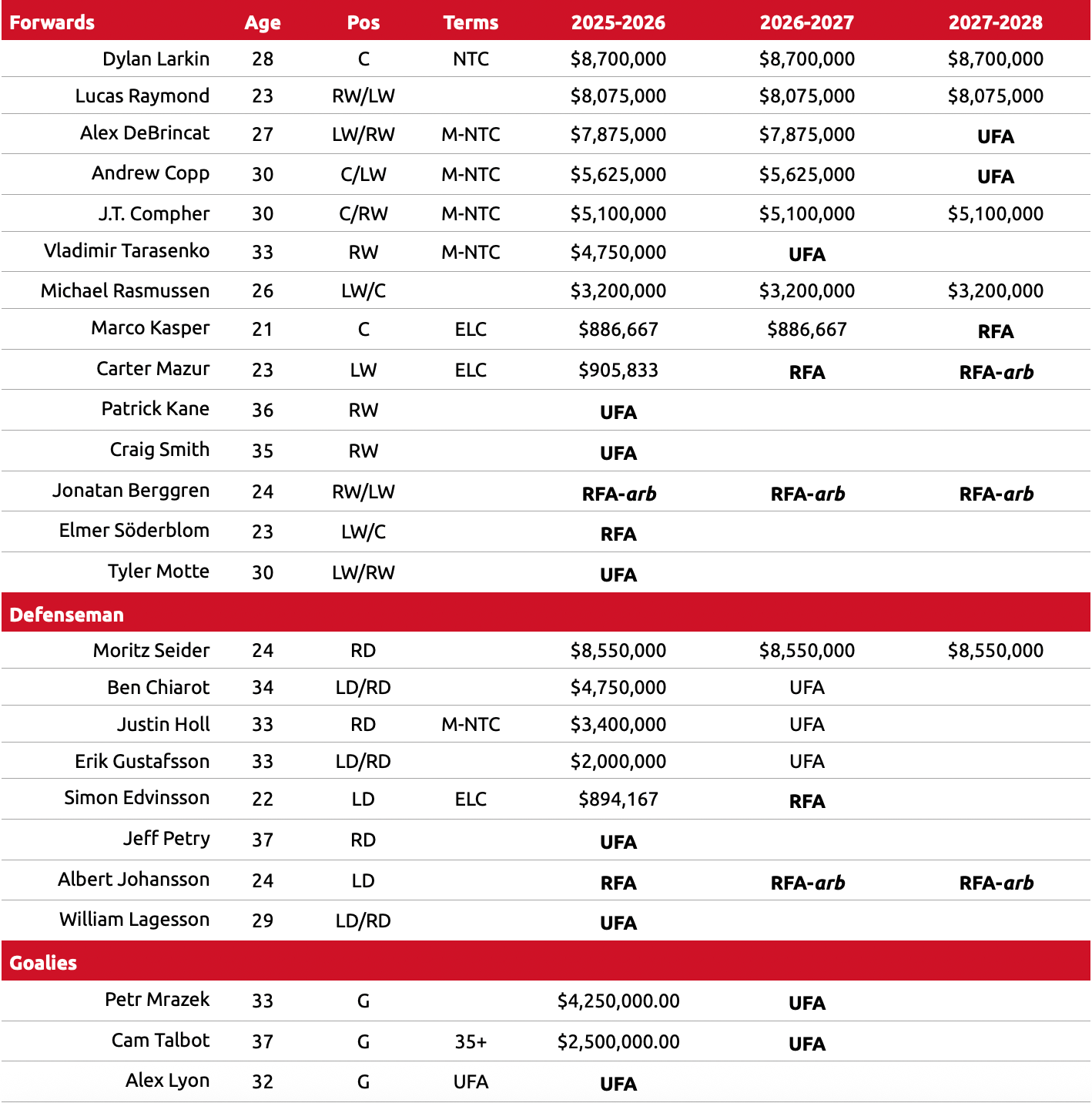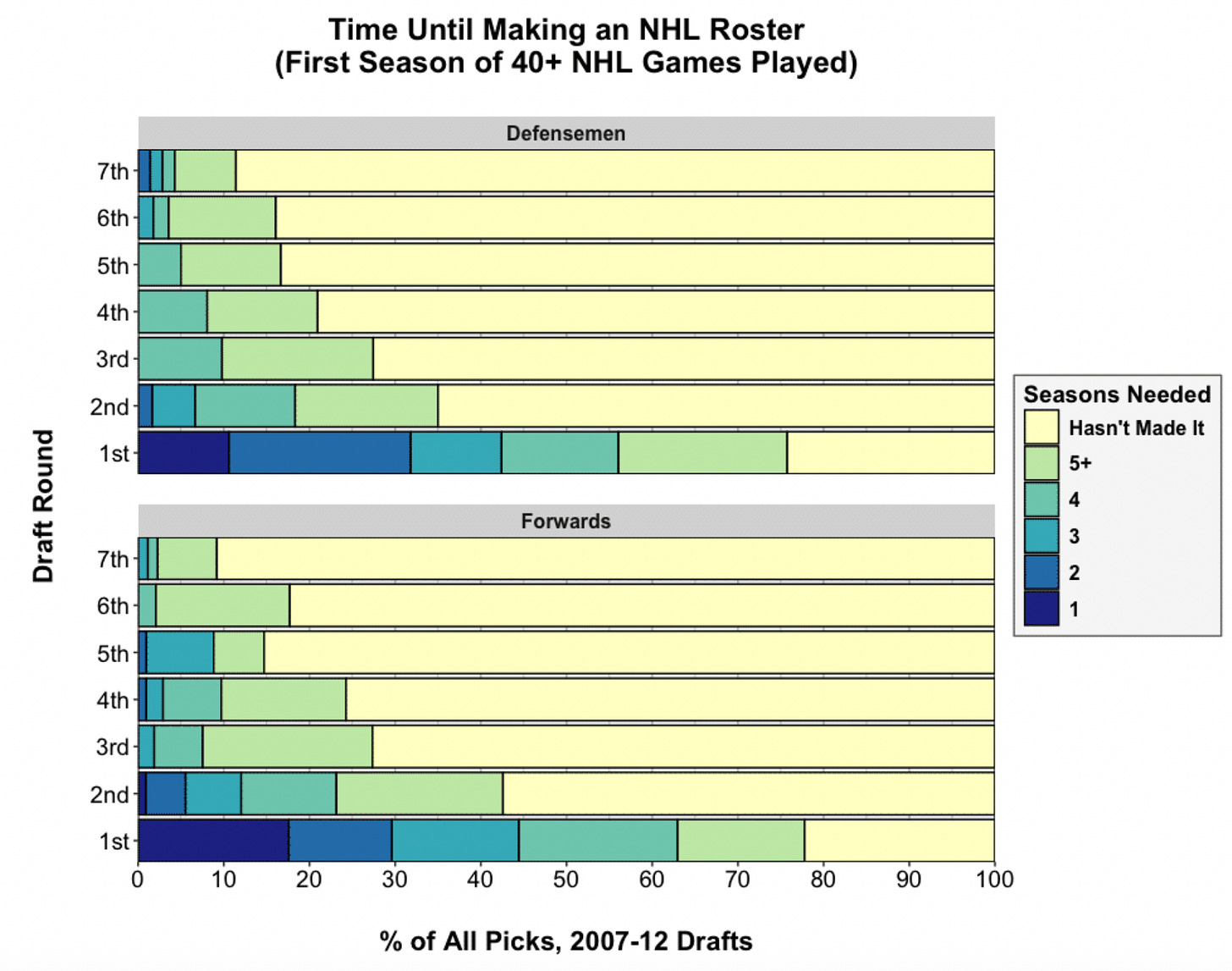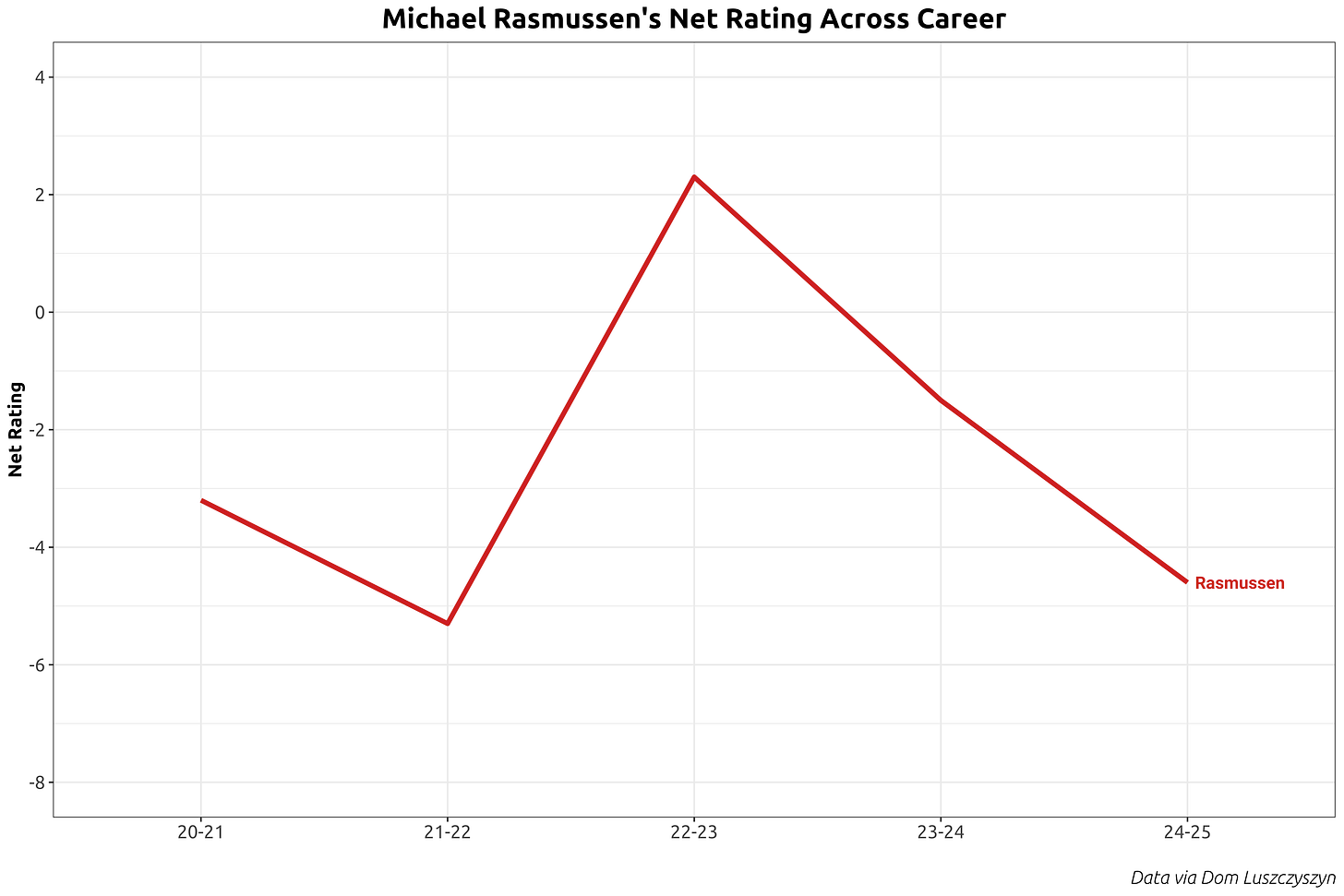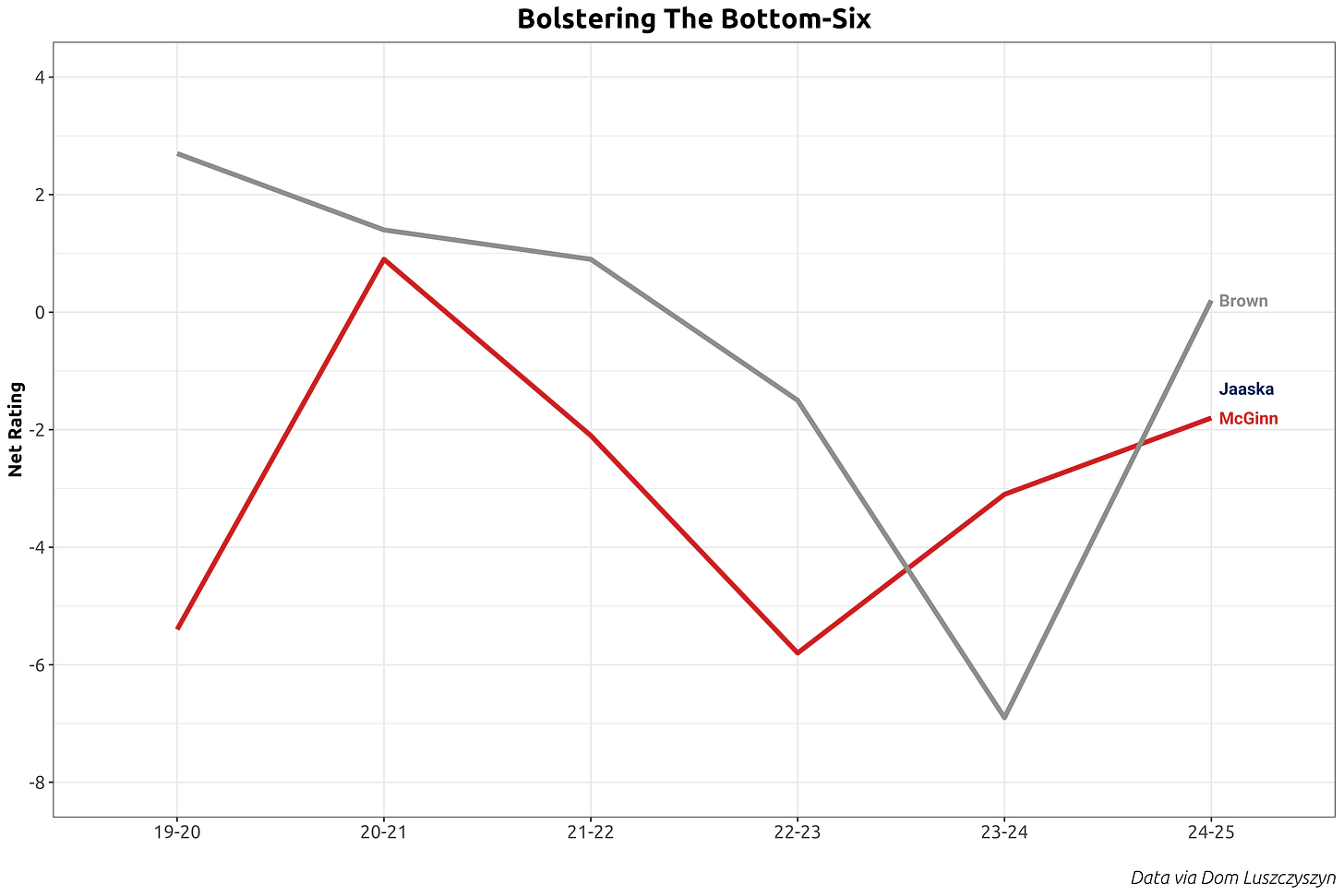If I Were Steve Yzerman (2025) - Part 2
In Part 1, I outlined where the Wings are currently and identified some key priorities to address this offseason to prepare the team for a contention window of 2026-27 to 2031-32. Essentially, these priorities can be group into two main focus areas for our moves:
Optimize our cap structure heading in to our contention window of 2026-2027. This means avoiding longer term deals (6+ years) for non-elite core and looking to shed some of our expensive depth core pieces
Make competitive offers (trade and free agency) for truly high-end players that would fit our competitive window and immediately be a part of our “Elite Core”. If we can’t successfully land elite talent, we’ll fall back to signing free agent targets that will make us incrementally better in the short-term. Importantly, we will keep these deals to 3 years or less to allow us cap flexibility once in our contention window.
Let’s get started by examining Detroit’s salary cap situation and making decisions on Detroit’s current free agents
The Cap Situation


As it stands, the Wings have 16 players (9F, 5D, 2G) on the active roster under contract for a total of $73,388,373 in cap hits. With the cap at $95.5 million (and poised to go up to $104 million next year), that leaves the Wings with just over $22 million in cap space. Before they can go shopping, decisions have to be made on the restricted and unrestricted free agents.
Detroit’s Free Agents
Starting with the easier decisions, I am comfortable not extending new contracts to unrestricted free agents Alex Lyon, Craig Smith, Tyler Motte, William Lagesson, and Jeff Petry. In goal, the Wings already have Mrazek and Talbot under contract and while both were inconsistent, I would rather utilize Sebastian Cossa as a potential 3rd goalie when needed to get additional NHL data points on him prior to the expiration of his entry-level contract (ELC) at the end of 2025-2026.
On the blueline, I’m comfortable replacing William Lagesson’s 8D role internally by providing opportunities for Shai Buium, William Wallinder, and/or Anton Johansson should the need arise. As a fallback, I’ll bring back defenseman Brogan Rafferty on a one-year, two-way contract for the league minimum $775,000 as an additional veteran option with the intention that he plays primarily in Grand Rapids. As for Jeff Petry, I’m going to opt to shop in UFA for a younger, more mobile defenseman.
Finally at forward, while both Motte and Smith were serviceable 4th liners I will replace those roles through a combination of internal promotion and free agency.
This brings us to decisions on four players - Jonatan Berggren, Elmer Söderblom, Albert Johansson, and Patrick Kane. For Johansson, it’s a no-brainer to get a deal done for him - the question is how long do you sign him for? The Wings have Johansson’s rights until the 2028-2029 season. To avoid walking him directly to free agency, I’ll offer Johansson a two-year deal at $925,000 average annual value (0.97% cap hit%) using recent comps of Cale Fleury (2 years, 0.96% cap hit%) and Kevin Bahl (2 years, 1.26% cap hit%).
For Söderblom, he showed tremendous growth this past season in his skating and decision-making with the puck, earning the trust to play on the top line at times. With Söderblom, the Wings have his rights until the 2029-2030 season. Similar to Johansson, I’ll stop short of walking him to free agency by offering Söderblom a two-year deal at $975,000 AAV (1.02% cap hit%) using recent comps of Rasmus Asplund (2 years, 1.01% cap hit%) and Rasmus Kupari (2 years, 1.20% cap hit%).
For Berggren…it’s a tough call. We’ve now got 150+ games of Berggren in the NHL and his strengths and weaknesses are apparent. He’s a gifted passer with a deceptive shot who does not significantly impact puck possession and lacks the defensive game to be able to play higher in the lineup. The Wings ran into a similar dilemma recently with Joe Veleno as they continued to bring him back in the hopes that they would see more before they finally moved him at the deadline in the deal for Craig Smith. Thinking about how Detroit’s already struggling with overpaid depth, I’m hesitant to commit again to Berggren. With Berggren, I’d rather explore his value in the trade market to either acquire a late round draft pick or use him as a sweetener to shed a contract for a defenseman.
Last but not least is Patrick Kane. Last season, Kane took an incentive-laden contract that had a base cap hit of $4 million + $2.5 million in performance bonuses ($1.5 million for 10 GP, $250K for 60 GP, $250K for 60 points + team playoffs). At this point in his career, you know exactly what you’re going to get from Patrick Kane. He’s capable of driving an elite power play unit as one of the most gifted passers in the game and he’ll likely score at a 20-goal, 50-point pace over a full season. However at his age, Kane picks his spots to attack at 5v5, leading to inconsistent results at even strength. If you’re counting on him to be an impact player at 5v5 in your top-six, this probably isn’t the move to elevate Detroit.
However, I think there’s some value here if the Wings can fit Kane into a role that’s heavy on power play time but middle-six winger minutes at even strength, similar to what they did with Thomas Vanek in 2016-2017. If amenable to that type of usage, I would offer Kane a 1-year, $3 million deal with $2.5 million in performance bonuses ($500K for 10 games played, $500K for 60 games played, $1.5 million for 60 points + playoffs). I’d be comfortable stretching as high as $3.5 million on the base salary but would be wary of committing more than that without knowing if I’ll be able to shed salary.
After addressing the internal free agents, I currently have 11 forwards, 6 defensemen, and 2 goalies signed with $17.2 million remaining in cap space (remembering that I need to be mindful of avoiding another overage charge should Kane hit his performance bonuses again).
After addressing the free agents, there’s one other additional piece of business that I would ideally attend to this offseason - a contract extension for Simon Edvinsson.
The Simon Edvinsson Extension
After July 1st, Edvinsson will be eligible to sign a contract extension. With Seider and Raymond, the Wings were unable to get a deal done early and ultimately got them both settled shortly before the start of last season. Both deals are still likely to be “team-friendly” given the substantial improvements made by both players last year; however it would be wise for the Wings to prioritize an early extension with Edvinsson to see if they can land a longer, team-friendly deal similar to what the Carolina Hurricanes did with Brett Pesce back in 2017. With the Wings having Edvinsson’s rights until 2030-31, they could opt for a short 2-3 year extension taking Edvinsson through his age-25 season or they could opt for a longer 6-8 year extension taking Edvinsson through his age 28-30 seasons.
The shorter bridge was a path taken by the New York Islanders and Noah Dobson. At the time the sides opted for a three-year deal at a 4.85% cap hit%. Now Dobson is an RFA with arbitration rights and is set to negotiate his next deal with the Islanders, one that Evolving-Hockey projects to come in at 8 years, $10.12 million AAV (10.6% cap hit%). Obviously Dobson developing the way he did is a great problem for the Islanders to have but the Islanders could have potentially enjoyed this current stretch of play on a cheaper deal had they been able to come to an agreement on a longer-term deal the first time around.
Alternatively, Hampus Lindholm’s first extension was a six-year deal at 7.83% cap hit%. Lindholm signed the deal after the completion of his ELC so the Ducks did have an additional year of data compared to what the Wings have right now; however you can see that Lindholm’s level plummeted over the course of the deal, rebounding only after he was dealt to Boston. It’s a tale of two strategies with two differing outcomes. If I had to bet, I’d bet that Edvinsson continues to develop similar to Dobson. Given this, I’d like to offer Edvinsson’s camp a six-year deal at $6.5 million AAV (6.25% cap hit%) using comps of Sam Girard (7 years, 6.13% cap hit%) and Shea Theodore (7 years, 6.54% cap hit%). I’m not sure this gets it done and I’d be comfortable going up to 8 years at an $8 million AAV, but I at least want to get the negotiations started on a potential team-friendly steal to kickstart the competitive era.
Join me in this fantasy land
Now that we’ve taken care of the free agents, let’s shift to the specific moves I’d like to make this offseason. To the best of my abilities, I tried to make moves that I believe to be fair, realistic, aligned to team priorities, and aligned to similar historical moves. With each move, I’ll offer why I think the move makes sense as well as what I consider to be the potential risks. So come join me in this fantasy world.
Offload Justin Holl with a sweetener
To San Jose: Rights to Jonatan Berggren, Justin Holl (no salary retained)
To Detroit: Conditional 2026 4th round pick (DET receives latest of SJ’s two 4th round picks)
Why I think it makes sense
For Holl, the fit in Detroit has just not worked out. He’s often found himself a healthy scratch and was waived at the beginning of last season. At $3.4 million and the likely #7 defenseman on the current roster, I’d like to get out of what essentially amounts to dead cap space when he’s not playing. With his contract expiring at the end of the year and the cap going up significantly, there may be a few teams willing to absorb Holl’s contract. In particular, the San Jose Sharks currently have 16 players under contract but are still ~$17 million away from the salary cap floor. Sharks’ GM Mike Grier has shown a willingness to take on these cap “dumps” the last couple of years and would conceivably take on Holl with a sweetener attached.
In this case, I think the sweetener that makes the most sense is Jonatan Berggren. Berggren, a couple weeks shy of his 25th birthday, is an above average passer with a good offensive IQ and a deceptive shot. However, he is a below average forechecker, does not tilt the puck possession battle, and often gets out of position in defensive zone coverage. Now 150+ games into his NHL career, it’s relatively clear that Berggren is an undersized bottom-six winger that scores at ~0.35 points/game, doesn’t kill penalties, and doesn’t tilt the possession battle. I think his offense can be replaced easily and instead of continuing to bring him back, I’d rather move him in a deal to create cap space and a roster spot.
What’s the risk?
With giving up Berggren, there’s always the potential risk that he flourishes somewhere else. Thinking about scenarios, one name that comes to mind is Eeli Tolvanen and how he was able to elevate his play after being claimed by Seattle off waivers from Nashville. Tolvanen, similar to Berggren, had been in the Predators organization for awhile with more than 130 games played before he was placed on waivers. I think the chances of Berggren having a “glow-up” similar to Tolvanen are unlikely, but it’s a risk nonetheless.
Take a risky swing on the blue line
To Calgary: Michael Rasmussen, 2025 1st round pick, 2026 3rd round pick (DET)
To Detroit: Rasmus Andersson, 2025 1st round pick (FLA)

Why I think it makes sense
Alright stick with me here as there are a few things we need to unpack related to why I think this makes sense. First, let’s unpack the deal from Calgary’s perspective. Rasmus Andersson’s name has been floating around as a potential trade target as he enters the last year of his deal in Calgary. Recent comments from Daily Faceoff’s Frank Seravalli speculate that the Flames “realize that Rasmus Andersson, for the long haul, is probably going to be too expensive and too long-term for their liking”. When considering what Calgary’s interested in, The Athletic’s Pierre LeBrun speculated that the Flames are looking to upgrade at center, particularly a “center with more size” .
Why would the Flames be willing to part with Andersson? Arguably the area the Flames’ prospect pool is deepest at is RD with Zayne Parekh, Hunter Brzustewicz, and Henry Mews. Finally, while the Flames have two 1st round picks in the 2025 draft, they are both outside the lottery at 18th (from NJ) and 32nd (from FLA) as Montreal owns the Flames’ 1st round pick this year. In their efforts to further rebuild, they may have interest in effectively doubling the value of one of their 1st round picks (equivalent to the Flames adding another late 1st round pick).
From Detroit’s perspective, the 2025 1st round pick should be on the trade block. Thinking about the proposed contention window beginning in 2026-2027, it’s highly unlikely that the 13th overall pick from this year’s draft would be debuting at the NHL level any sooner than 2027-2028.

If I’m trying to build a team that can contend as soon as 2026-2027, I’m willing to shop this pick. Oh and I also have a top-5 prospect pool that still has several players en route to the NHL.
With Michael Rasmussen, it’s been an up and down career thus far. After a promising 2022-2023 season where he scored 10 goals and 29 points in 56 games, Rasmussen has taken a step back each of the past two years. Rasmussen managed just 11 goals and 21 points in 77 games played this year. Under McLellan, Rasmussen saw his ice time dip below 13 minutes a game before Andrew Copp’s injury forced him back into a larger role. Now 26 years old and signed for three more years at $3.2 million per season, I don’t think we’re going to get the jump a lot of us hoped for from Rasmussen. By Net Rating, he’s below the “exception” level for the Depth Forward role, suggesting he’s a candidate to be replaced by a more cost-effective option. I’d like to leverage teams interested in his size, potential, and cost control and use him in this deal.
Why Rasmus Andersson? As a 28-year-old right shot defenseman capable of eating tough minutes, I don’t think I have to make much more of a sell - however I’m going to anyways. Right now, this is arguably the best time to buy on Andersson. He’s coming off a down year where he scored only 31 points in 81 games, down from his career high of 50 in 2021-22 and 2022-23. Part of that can be attributed to injury as he played a handful of games with a broken leg. Part of it can be attributed to Calgary’s rebuild. Whatever the case may be, Andersson’s never going to be cheaper.
At his peak just two years ago, Andersson was one of the top offensive defensemen in the game. There’s certainly some concern with the drop in his production the last two years but I’m betting on it being a combination of injuries, a worse team in front of him, and tough competition.
In Detroit, Andersson would be able to take on a more sheltered role as he’d play on the 2nd pair behind Seider on the right side. Adding Andersson would allow McLellan the option to ease Seider’s minutes even more and add some more offensive pop from the blue line. In this more sheltered role, I think Andersson would be a tremendous candidate for a bounceback season.
From a trade comp perspective, I looked back to last year’s deal between Ottawa and Washington where the Capitals acquired Jakob Chychrun for Nicklas Jensen and a 3rd round pick. At the time of the deal, Chychrun had one year remaining (similar to Andersson) and Ottawa was concerned that they would not be able to re-sign him. While the circumstances aren’t exactly the same, they are reasonably close and offer us the framework to build a potential deal.
My two cents? The deal feels a little light. I’ve tried to up the value a bit with the 1st round pick swap but even then I’m not certain it’s enough. However, it’s more than Washington paid for a similar caliber defenseman in Chychrun so we will run with this deal for the purpose of this exercise. Alternatively, if the 1st round pick swap doesn’t entice Calgary enough, the deal could be reframed around Nate Danielson from Detroit’s end.
What’s the risk?
With this deal there are two main risks (three if you include electric scooters in Detroit) - will you be able to re-sign Andersson and if you do, what happens if he doesn’t bounce back? The way I plan to approach this is similar to how Carolina managed Mikko Rantanen. Adding Andersson would offer the Wings a firsthand look at how he’d fit in to the lineup and if he doesn’t fit the way Detroit would like or there are concerns about getting an extension done, the Wings would be able to sell high at the trade deadline and recoup some value. Part of the willingness to part with DET’s 1st round pick is knowing that the Wings may be able to get a 2026 pick back if they need to shop Andersson at the trade deadline.
Upgrade the bottom-six
Sign Connor Brown for two-years, $2.8 million AAV
Sign Brock McGinn for one-year, $925,000 AAV
Sign Juha Jääskä for one-year, $900,000 AAV
Why I think it makes sense
After allowing Motte and Smith to depart and dealing Berggren and Rasmussen, we need to rebuild our bottom-six. My focus on the bottom-six is a cost-effective bottom-six that can forecheck aggressively, play with pace, kill penalties, and provide occasional scoring. Connor Brown would be the primary piece here after a strong season in Edmonton. After a lengthy recovery from an ACL injury, Brown finally looked like his old self scoring 13 goals and 30 points while playing important minutes on the penalty kill. With Brown likely to become a cap casualty in Edmonton, he’d be an excellent addition to the bottom-six and would immediately help the Wings’ woeful penalty kill.
I appear to have a type in looking for players to bounce back from ACL injuries as Brock McGinn is scheduled to be ready shortly before the start of the season as he recovers from his ACL injury that sidelined him early in the 2024-2025 season. McGinn is a player known for his speed and forechecking ability. Earlier in his career, he was an effective role player for the Carolina Hurricanes and scored some timely goals in the playoffs. Since leaving Carolina, he’s struggled to contribute consistently and has played only 50 games in the last two seasons for the Ducks. In my eyes, McGinn is essentially being brought in as the 12th/13th forward in a low-risk situation. If he’s able to stay healthy and add some speed and forechecking to the 4th line, that will be a nice win for the Wings. If not, there’s little lost on a one-year deal at $925,000.
Last but not least is Juha Jääskä who made his NHL debut this year with the Carolina Hurricanes. Jääskä had played for HIFK in Liiga the last several years before joining the Hurricanes organization in April 2024. Jääskä has some appeal as a potential 13th/14th forward that can play center and play a grinding game on the 4th line. Again, another low-risk deal to bring in a veteran that can jump into some NHL games when needed.
What’s the risk?
Does anyone have a couple of ACL’s to spare just in case? The biggest risk here is the injury history associated with Brown and McGinn and if Brown’s bounce-back last year was an anomaly. In McGinn’s case, it’s a low-cost, one-year deal at a minimal cap hit so it’s unlikely to pose a significant problem. In Brown’s case, I’ve tried to keep the potential risk down by opting for a two-year deal. AFP Analytics has Brown projected at three years, $2.9 million and Evolving-Hockey has Brown projected at three years, $2.08 million. I think Brown’s strong year gets him closer to the $2.9 million AAV so I’m hoping that by offering him that, I can minimize risk by limiting the term to two years.
Adding the final piece on the blue line
Sign Nate Schmidt for three-years, $3.6 million AAV
Why I think it makes sense
After adding Rasmus Andersson to the top four and offloading Justin Holl, the blue line is starting to look a bit more dynamic. However, the left side of the defense is still looking a little bleak behind Simon Edvinsson with Ben Chiarot, Albert Johansson, and Erik Gustafsson. While everyone else takes their runs at Aaron Ekblad and Vladislav Gavrikov, I think it’s a great opportunity to land a Stanley Cup champion in Nate Schmidt.
No longer playing top-pairing minutes, Schmidt has thrived in a fringe 2nd pair/3rd pair role with Winnipeg and Florida the last two seasons. In that smaller role, Schmidt has been a puck possession monster and when the playoffs finally came, Schmidt delivered three goals and 12 points in 23 games. At 33 he is approaching the end of his career but he’s clearly demonstrated that he’s still got plenty in the tank.
The key to this signing being a success is to not ask too much of Schmidt. In Detroit, I would bring in Schmidt to play on the 2nd pair with Rasmus Andersson and take a share of PP2 minutes. With Seider’s pairing taking the tougher matchups, Schmidt would have an opportunity to continue what he’s been able to do in Winnipeg and Florida. The other added bonus in Detroit is being able to offer him PP2 minutes. Between Seider, Andersson, and Schmidt, the Wings would have three players capable of playing the power play QB role.
What’s the risk?
As promising as Schmidt’s season was, it did come on an absolutely loaded Florida Panthers team. Will Schmidt be able to sustain his same level of play on a much less talented Red Wings team in a slightly larger role? Furthermore, I’m committing three years to Schmidt in order to make my offer more enticing for him as I suspect his playoff performance will attract other suitors. There’s a risk in seeing how Schmidt ages over the course of the deal.
A Swing For The Fences
Sign Nikolaj Ehlers for seven years, $9 million AAV
Why I think it makes sense
Alright folks, this is the riskiest move I’m making but I think it’s a calculated risk that makes sense for Detroit given our proposed contention window. I’ve stated previously that the Wings need another top-six forward so that all hopes are not riding on Marco Kasper’s development. The free agency forward market this year is relatively thin and with us already spending our 2025 1st on Andersson, I’m hesitant to spend future firsts to explore another trade. That leaves me with taking a run at Mitch Marner or Nikolaj Ehlers and of the two, I feel more confident in my ability to competitively bid for Ehlers.
Ehlers is an interesting player to examine. At a glance, you see a 29-year-old, 6’0”, 175 lb winger that has never topped 65 points in a season and only played more than 18 minutes/night once in his career. For as immensely talented as he is, Ehlers simply hasn’t earned the trust of his coaches to play the big minutes. Despite this, Ehlers has stuffed the stat sheet and driven possession about as well as you can in the role he’s been given. For more on Ehlers, please check out the above write-up from Garret Hohl as it goes well beyond my capabilities.
In particular, he does two things that Detroit sorely lacks - he carries the puck through the neutral zone well and once in the offensive zone, he creates offense. In my eyes, his play-driving capabilities from the winger position offer the perfect complement to the Wings’ top-6 and Todd McLellan’s rush offense.
What’s the risk?
Seven years at $9 million (9.4% cap hit%) for a soon-to-be 30-year-old winger is steep. It’s risky and could potentially be a hindrance to Detroit’s contention window if Ehlers is unable to elevate his game in a larger role in Detroit. Ehlers has struggled to convince three separate coaches to trust him with more ice time at even strength, so who’s to say that McLellan is the one that unlocks more from him. But at this point, I don’t think I can afford to wait for next year’s free agent crop or the potential development of a Dmitri Buchelnikov or Max Plante. With time winding down on DeBrincat’s contract and Larkin rapidly approaching 30, I feel compelled to take a big swing to give this core group, with Larkin at the forefront, a legitimate shot at the playoffs.
Meet the 2025-2026 Detroit Red Wings
Well there you have it folks. We made it to the very end and this is what our 2025-2026 opening night lineup looks like. I think this roster is much more balanced and is capable of contending for the 3rd seed in the Atlantic Division. There are certainly some question marks with this team, namely the smaller stature of the top-six and the gigantic shrug emoji of the goaltending situation. However, with the opening of our contention window being 2026-2027, I think the Wings can delay addressing that situation until next offseason when they have additional data on Cossa, Augustine, and Carter Gylander.
Here you’ll see the salary cap breakdown for this team. The roster comes in at $93.46 million leaving us with ~$2 million in space to account for Kane’s potential performance bonuses. Importantly, we have a number of expiring contracts that will allow us to further reshape our bottom-six depth, defense group, and goaltending next offseason. I think the players added this offseason help the team get better immediately and the players that were given term are ones who I foresee being impactful well into the contention window.
I thank those of you that made it this far and welcome your thoughts and opinions on this exercise!















Always count on Prashanth for realistic deals with logical lines of reasoning behind them.
None of this silly Nate Danielson and a bag of pucks for Jason Robertson nonsense.
I really like the roster. I like that you also didn't just plug ASP in like some are quick to do. I don't think he starts in the NHL. He could fight his way in next season but if that's the case, I don't think it would be because the wings are in serious contention of a playoff spot.
Nate Schmidt is an interesting depth role that I hadn't considered.
Ehlers - I am thinking if the wings do sign him, it would be just under the Larkin contract - even considering the cap increase. So perhaps more likely that they get outbid. If they get him around larkin's number, that could account for all of Kane's performance bonuses as well.
I liked the line of thinking used for the Andersson deal and comps. If I had to guess, that probably won't be enough talent at C for CGY to take the deal. They may lean more towards a deal that has a slightly better player than picks in it.
You covered most of the bases.
One more possibility I think we could see is a move to acquire a slightly better goalie with term. The wings are "fine" with their goaltending situation. But there has been rumblings of them in the market still. Some term could bring assurance to backstop the Cossa timeline, though is not critical right now. Could still solve this a year from now.
Great read!
This is hands down the best off-season plan I've seen so far.